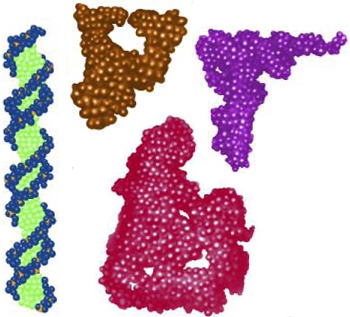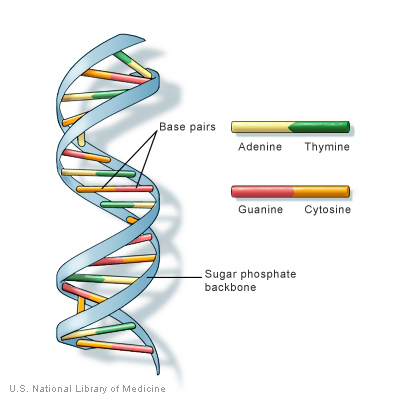THE BIOCHEMICAL REACTIONS

- DNA replication begins with the "unzipping" of the parent molecule as the hydrogen bonds between the are broken.
- Once exposed, the sequence of bases on each of the separated strands serves as a template to guide the insertion of a complementary set of bases on the strand being synthesized.
- The new strands are assembled from
- Each incoming nucleotide is covalently linked to the "free" 3' carbon atom on the pentose (figure) as
- the second and third phosphates are removed together as a molecule of (PPi).
- The nucleotides are assembled in the order that complements the order of bases on the strand serving as the template.
- Thus each C on the template guides the insertion of a G on the new strand, each G a C, and so on.
- When the process is complete, two DNA molecules have been formed identical to each other and to the parent molecule.
THE ENZYMES

- A portion of the double helix is unwound by a
- A molecule of aDNA polymerasebinds to one strand of the DNA and begins moving along it in the 3' to 5' direction, using it as a template for assembling aleading strand of nucleotides and reforming a double helix. In eukaryotes, this molecule is called DNA polymerase delta (δ).
- Because DNA synthesis can only occur 5' to 3', a molecule of a second type of DNA polymerase (epsilon, ε, in eukaryotes) binds to the other template strand as the double helix opens. This molecule must synthesize discontinuous segments of polynucleotides (calledfragments). Another enzyme, then stitches these together into the
DNA Replication is Semiconservative
When the replication process is complete, two DNA molecules — identical to each other and identical to the original — have been produced. Each strand of the original molecule has- remained intact as it served as the template for the synthesis of
- a complementary strand.
Bacteria
The single molecule of DNA that is the genome contains 4.7 x 106nucleotide pairs. DNA replication begins at a single, fixed location in this molecule, the proceeds at about 1000 nucleotides per second, and thus is done in no more than 40 minutes. And thanks to the precision of the process (which includes a "proof-reading" function), the job is done with only about one incorrect nucleotide for every 109 nucleotides inserted. In other words, more often than not, the E. coli genome (4.7 x 106) is copied without error!Eukaryotes
 The average human chromosome contains 150 x 106 nucleotide pairs which are copied at about 50 base pairs per second. The process would take a month (rather than the hour it actually does) but for the fact that there are many places on the eukaryotic chromosome where replication can begin. Replication begins at some replication origins earlier in S phase than at others, but the process is completed for all by the end of S phase. As replication nears completion, "bubbles" of newly replicated DNA meet and fuse, finally forming two new molecules.
The average human chromosome contains 150 x 106 nucleotide pairs which are copied at about 50 base pairs per second. The process would take a month (rather than the hour it actually does) but for the fact that there are many places on the eukaryotic chromosome where replication can begin. Replication begins at some replication origins earlier in S phase than at others, but the process is completed for all by the end of S phase. As replication nears completion, "bubbles" of newly replicated DNA meet and fuse, finally forming two new molecules. With their multiple origins, how does the eukaryotic cell know which origins have been already replicated and which still await replication?
An observation: When a cell in G2 of theis fused with a cell in S phase, the DNA of the G2 nucleus does not begin replicating again even though replication is proceeding normally in the S-phase nucleus. Not until mitosis is completed, can freshly-synthesized DNA be replicated again.
Two control mechanisms have been identified — one positive and onenegative. This redundancy probably reflects the crucial importance of precise replication to the integrity of the genome.
 In order to be replicated, each origin of replication must be bound by:
In order to be replicated, each origin of replication must be bound by:- an OriginRecognition Complex of proteins (ORC). These remain on the DNA throughout the process.
- Accessory proteins called licensing factors. These accumulate in the nucleus during G1 of the cell cycle. They include:
- Cdc-6 and Cdt-1, which bind to the ORC and are essential for coating the DNA with
- MCM proteins. Only DNA coated with MCM proteins (there are 6 of them) can be replicated.
- Cdc-6 and Cdt-1 leave the ORCs (the latter by and destruction in
- The MCM proteins leave in front of the advancing replication fork.
As the cell completes mitosis, geminin is degraded so the DNA of the two daughter cells will be able to respond to licensing factors and be able to replicate their DNA at the next S phase.















